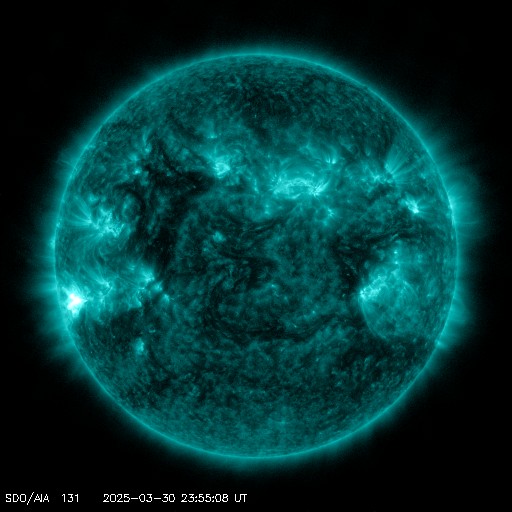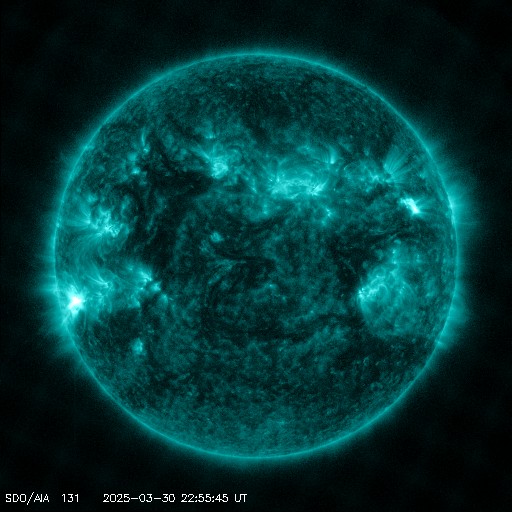Viewing archive of Friday, 4 March 2011
Solar activity report
Any mentioned solar flare in this report has a scaling factor applied by the Space Weather Prediction Center (SWPC). Because of the SWPC scaling factor, solar flares are reported as 42% smaller than for the science quality data. The scaling factor has been removed from our archived solar flare data to reflect the true physical units.
Report of Solar-Geophysical Activity 2011 Mar 04 2200 UTCPrepared by the NOAA © SWPC and processed by SpaceWeatherLive.com
Joint USAF/NOAA Report of Solar and Geophysical Activity
SDF Number 063 Issued at 2200Z on 04 Mar 2011IA. Analysis of Solar Active Regions and Activity from 03-2100Z to 04-2100Z
Solar activity was low. Several small C-class flares
were observed from Region 1164 (N23W14). This region was classified
as an Ekc type spot group with Beta-Gamma-Delta magnetic
characteristics. Region 1166 (N09E55) more than tripled in size
over the past 24 hours and the number of spots doubled. Region 1166
was classified as an Eac type spot group with Beta magnetic
characteristics. Region 1168 (N24W73) emerged on the disk as a
small bipolar group. Two East limb CMEs were observed in both SOHO
LASCO and STEREO imagery, although neither appeared to be
Earth-directed.
IB. Solar Activity Forecast
Solar activity is expected to be low.
More C-class flares are expected from Regions 1164 and 1166, with a
chance for an M-class flare.
IIA. Geophysical Activity Summary 03-2100Z to 04-2100Z
The geomagnetic field was quiet to unsettled. A waning coronal hole
high speed stream remained geoeffective and solar wind speed at the
ACE spacecraft was approximately 500 km/s. The greater than 2 MeV
electron flux at geosynchronous orbit was at high levels throughout
the period.
IIB. Geophysical Activity Forecast
The geomagnetic field is
expected to range from quiet to active levels with a slight chance
for minor storm periods at high latitudes for the next three days
(05-07 March). Model guidance suggests a possible arrival on day
two (06 March) of an Earth-directed CME observed early on 03 March.
This slow-moving CME is expected to bring a slight chance for major
storm conditions at high latitudes. Activity levels are anticipated
to decrease on day three (07 March).
III. Event Probabilities 05 Mar to 07 Mar
| Class M | 35% | 35% | 35% |
| Class X | 01% | 01% | 01% |
| Proton | 01% | 01% | 01% |
| PCAF | Green | ||
IV. Penticton 10.7 cm Flux
Observed 04 Mar 127 Predicted 05 Mar-07 Mar 125/125/125 90 Day Mean 04 Mar 089
V. Geomagnetic A Indices
Observed Afr/Ap 03 Mar 011/012 Estimated Afr/Ap 04 Mar 010/012 Predicted Afr/Ap 05 Mar-07 Mar 010/012-008/010-005/010
VI. Geomagnetic Activity Probabilities 05 Mar to 07 Mar
| A. Middle Latitudes | |||
|---|---|---|---|
| Active | 20% | 25% | 05% |
| Minor storm | 05% | 10% | 01% |
| Major-severe storm | 01% | 05% | 01% |
| B. High Latitudes | |||
|---|---|---|---|
| Active | 25% | 30% | 25% |
| Minor storm | 10% | 15% | 10% |
| Major-severe storm | 05% | 10% | 05% |
All times in UTC
Current data suggests there is a slight possibility for aurora to appear at the following high latitude regions in the near future
Gillam, MB, Yellowknife, NTLatest news
Latest forum messages
Solar Demon 3Unspecified geomagnetic activity 2146AR4046 134Aurora photography hints for those of us with smartphones 54AR4048 34
More topicsSupport SpaceWeatherLive.com!
A lot of people come to SpaceWeatherLive to follow the Sun's activity or if there is aurora to be seen, but with more traffic comes higher server costs. Consider a donation if you enjoy SpaceWeatherLive so we can keep the website online!

Latest alerts
00:09 UTC - Solar flare
Moderate M1.03 flare
Sunday, 30 March 2025
23:51 UTC - Radio Blackout
Minor R1 radio blackout in progress (≥M1 - current: M1.03)
23:39 UTC - Solar flare
Moderate M1.52 flare
23:21 UTC - Radio Blackout
Minor R1 radio blackout in progress (≥M1 - current: M1.49)
23:09 UTC - Solar flare
Moderate M1.48 flare
Space weather facts
| Last X-flare | 2025/03/28 | X1.1 |
| Last M-flare | 2025/03/30 | M1.0 |
| Last geomagnetic storm | 2025/03/27 | Kp5 (G1) |
| Spotless days | |
|---|---|
| Last spotless day | 2022/06/08 |
| Monthly mean Sunspot Number | |
|---|---|
| February 2025 | 154.6 +17.6 |
| March 2025 | 127 -27.6 |
| Last 30 days | 127 -25.7 |





